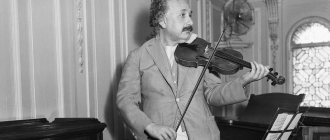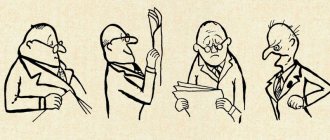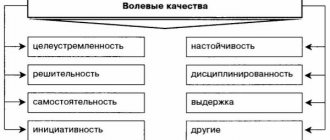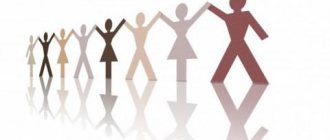Personality typology is a super-popular, in-demand area today both in classical science and its applied areas, and even in everyday life, everyday psychology. Attributing oneself to a type seems like an interesting activity. However, to prevent typing from becoming entertainment, such attribution must always be consistent with the purpose. Most often, this goal is for the person being typed, understanding his own individuality, to develop as a person, resolve psychological problems, and not just classify himself as one type and fence himself off.
Various authors describing personality differences described the concept of personality typology and, in the vein of differential psychology, the concepts of individuality, even temperament, and character as synonymous in their meaning, sometimes putting an equal sign between them. Individuality was considered by some in a broad sense as personality, character merged with personality. Here, differential psychology reveals discrepancies with general psychology, which separates, clearly delineating these concepts.
Individuality is traditionally defined by the sum of properties that separate one person from another. Properties can intersect and correlate with each other, forming stable characteristics. However, such a sum of properties is not yet a type. Considering the concept of personality typology, we now assume a set of not only interrelated traits, but those that together have a holistic structure, a gestalt organization. Differing from the classes of properties and simple associations, the type presupposes a strict identification of the framework of characteristics, reliance on these characteristics, the main feature that centers all the others.
What is personality typology in psychology
Personality typology in psychology is based on the division of people into psychotypes, depending on innate or acquired characteristics of character and temperament.
According to the scientific definition, a psychotype is a system of dominant behavioral attitudes of an individual when interacting with the outside world, based on the individual typological characteristics of an individual.
The systematization of behavioral stereotypes aims to explain the differences between people. Many psychologists and psychiatrists, representatives of various schools and directions, devoted their research to this topic.
Carl Jung's classification
Everyone has heard the words “introvert” and “extrovert”. These are the types of personality that Swiss psychiatrist Carl Jung identified in 1921. Over time, the typology, built on the identification of introverted and extroverted psychological attitudes, was refined and expanded by other scientists. It is convenient because it allows you to unambiguously determine the psychotype of a particular person and quite accurately predict the characteristic features of behavior.
Features of psychotypes according to C. Jung:
- Extrovert
. The consciousness of such a person is directed towards external objects. Internal processes are less important for him, the objective is more important than the subjective. Most of the time he is busy interacting with objects in the outside world. When planning their actions, an extrovert prefers to focus on circumstances to which they are able to adapt quite flexibly. He also often puts the interests of the team above his own. - Introvert
. People with this personality type are focused on internal processes and strive to depend less on external circumstances. For them, the subjective is more important than the objective; they focus on the value of their own interpretation of current events (an introverted psychological attitude should not be confused with an egocentric one). Read more about introverts in this article.
The reason for dividing people into types
The question of why in the same situation people behave differently, sometimes in sharply opposite ways, has arisen before everyone at least once in their life. In the modern world, which is developing at an accelerated pace, more and more attention is being paid to the study of psychotypes, both by specialists and individual citizens.
In psychology, with the help of typology, an individual psychological portrait of a person is compiled, which includes such qualities as:
- temperament;
- character;
- capabilities;
- inclinations;
- emotionality;
- motivation;
- personal values.
Despite the fact that the identified psychotypes according to any of the theories are practically never found in their pure form, everyone can identify the predominant features of one of the types. Based on the compiled psychological portrait, experts can predict the behavioral model of an individual in a given situation.
- Knowing the prevailing psychotype in oneself helps a person quickly find his purpose in life and increase self-esteem. A personal psychological portrait will tell you how to put your best qualities into practice and hide your shortcomings.
- Data from psychological tests and questionnaires are increasingly used by HR specialists when hiring. The same tests allow you to determine which assignment is best given to which employee. It is also important to select team members whose interaction will be aimed at optimally performing tasks accurately.
- Psychoanalysis allows you to identify weaknesses and predict the actions of a criminal or enemy. Used in law enforcement and military operations.
- Many people use personality typology when choosing a suitable partner for starting a family. Knowing the psychotypes of relatives and understanding their actions helps resolve or smooth out family conflicts.
- Drawing up a psychological portrait is of great importance for teenagers, as well as for their parents. Sometimes we have to admit that the goal chosen by parents is not suitable for the temperament and character of their child. Personality typology is an important component of choosing a professional direction.
- 1. Personality as a subject of social relations. Personality structure
- 2. Personality typology
- 3. Social statuses and roles. The role of the status-role structure of society
- 4. Socialization of the individual. Mechanisms and agents of socialization
LECTURE No. 5. Sociology of personality
1. Personality as a subject of social relations. Personality structure
One of the central areas of sociology is the study of personality.
This is due to a number of factors:
1) the individual is one of the main subjects of social relations;
2) the functioning of society is impossible without taking into account the needs and interests of the individual;
3) personality is an indicator of social development.
However, before we begin to consider personality, it is necessary to analyze such terms close to this concept as “person”, “individual”, “individuality”.
Human
- this is the highest level of living organisms on Earth, a subject of socio-economic activity and culture.
Individual
– an individual person as a representative of a family.
Individuality
- specific natural and social qualities that have developed in a person on the basis of inherited biological prerequisites, his social status and upbringing.
In the process of development of sociological knowledge, various approaches to the consideration and analysis of personality have been formed. Among them there are six main approaches
.
1. Dialectical-materialistic approach, according to which a person is initially a social being, and his formation as an individual occurs under the influence of four factors: the biology of the individual, his social environment, education and self-education skills.
2. An anthropological approach, in which a person is considered as a bearer of universal human properties, as a generic concept designating a representative of the human race, thus coinciding with the concepts of man and individual.
3. A normative approach, within which a person is defined as a social being with a number of positive qualities related to consciousness and activity.
4. Sociological approach, the essence of which is to understand each person as an individual, which is considered as a specific expression of the essence of the individual, a holistic embodiment and implementation in him of a system of socially significant features and qualities of a given society.
5. Personalistic approach, in which personality is a set of mental reactions of a person to the opinions of others about him, and the main mechanism of its formation is “I - perception”.
6. The biological-genetic approach assumes that human behavior is determined by his bioprogram.
Analyzing all of these approaches, we can give a systematic definition of personality, which should be based on the following principles:
1) the personality acts as both a subject and an object of both social and biological relations;
2) a person has a certain freedom to choose his behavior, which is determined by the discrepancy between social and biological conditions;
3) personality, being a biosocial phenomenon, combines both the traits of a person’s biological species and the social community in which it exists;
4) the behavior of an individual depends on his unique personal characteristics, through which social and personal life experience is refracted.
Taking into account all these principles, personality can be defined as an integral concept that characterizes a person as an object and subject of biosocial relations and unites in him what is universal, socially specific and individually unique.
The study and analysis of personality as a complex social phenomenon involves identifying its structure.
Based on the indicated characteristics of personality as a phenomenon, the following elements of its structure can be distinguished: biological, psychological and social.
Biological level
includes natural, common personality qualities (body structure, gender and age characteristics, temperament, etc.).
Psychological level
personality is united by its psychological characteristics (feelings, will, memory, thinking). Psychological characteristics are closely related to the heredity of the individual.
Finally, the social level of the individual is divided into three sublevels
:
1) proper sociological (motives of behavior, interests of the individual, life experience, goals), this sublevel is closely related to social consciousness, which is objective in relation to each person, acting as part of the social environment, as material for individual consciousness;
2) specific cultural (value and other attitudes, norms of behavior);
3) moral (morality, ethics).
When studying personality as a subject of social relations, sociologists pay special attention to the internal determinants of its social behavior.
Such determinants include, first of all, needs and interests.
Needs
– these are those forms of interaction with the world (material and spiritual), the need for which is determined by the characteristics of the reproduction and development of its biological, psychological, social certainty and which are realized and felt by a person in some form.
Interests
- These are the conscious needs of the individual. The needs and interests of an individual underlie his value attitude towards the world around him, the basis of his system of values and value orientations.
2. Personality typology
An important component of the sociological doctrine of personality is its typology.
Social personality type
- this is a way for a person to carry out various types of activities, a certain set of personality properties that expresses the individual’s belonging to a social group.
The concept of “social personality type” captures the reflection of a set of recurring social qualities of individuals belonging to any social community. As already indicated, personality is a complex multi-level phenomenon, which leads to the existence of various variations. Sociology has accumulated significant material on this problem. Let us dwell on the most developed and existing classifications.
The first attempt to create a personality classification system was made by E. Spranger
in 1914. The researcher developed
six “ideal types” of personality
based on their motivational orientation.
1) theoretical type – focus on obtaining new knowledge;
2) economic type - the basis of behavior is a pragmatic orientation;
3) social – desire for communication, focus on the social environment;
4) aesthetic – a tendency to impressions, experiences and self-expression;
5) political – the desire for dominance and distribution of social roles, as well as a tendency to submit;
6) religious – orientation towards the search for the highest meaning of life, communication with God.
At the same time, E. Spranger points out that all these types do not occur in their pure form, and in addition, there are many variations in the manifestation of the same type.
Another common classification in sociology is the division of personalities into basic and ideal. The basic personality is the personality most characteristic of certain social conditions.
Ideal type
- This is the person who best meets certain social conditions.
Thus, it is easy to see that in this case the basis of classification is the relationship between the individual and existing social conditions.
The difference between these personality structures is significant. The ideal, in principle, will never receive its final realization, but at any given moment it receives its embodiment in the basic type of personality.
However, it is easy to see that both of these types can also be divided into many subtypes, which may be based on other criteria.
Another classification is the typological system of E. Frome. The basis of his classification is the orientation of the individual in relations with society.
Thus, the basis of an unproductive personality is an unproductive orientation, that is, an inability to express oneself.
The basis of a productive personality is a productive orientation - the ability to change one’s environment and to express oneself.
However, the researcher himself notes that individuals with one type of orientation do not exist.
Typically, each personality combines both productive and unproductive orientations. The only question is which one dominates.
American sociologist D. Risman
proposed a division of all personality types, based on their orientation, into internal, external and “differently oriented.”
An internally oriented person has the ability to maintain a balance between the needs to achieve his life interests and the environment.
An externally oriented person is deprived of such an opportunity.
A “differently oriented” personality is able to respond to changes in the surrounding society.
Among the developments of domestic scientists in this area, one can note the identification of a new type of personality that emerged in the 30s. XX century under the influence of the socialist form of organization of public life.
This type is called the command-administrative personality type.
. This type of personality is characterized by such qualities as conformism, lack of autonomy, fear of conflicts, lack of focus on work results, lack of initiative, unwillingness to take risks, distrust of new things, hostility to change, intolerance to various deviations.
In modern conditions, under the influence of market reforms and democratic values, a new democratic type of personality is being formed in Russia.
3. Social statuses and roles. The role of the status-role structure of society
One of the most widespread theories of personality in modern sociology is the status-role concept.
Within the framework of this concept, a person is considered as an active subject who occupies a certain place in society and performs a set of functions in accordance with it.
The status-role concept was developed in the works of American sociologists J. Mead
and
R. Minton
.
The theoretical material of this theory was significantly enriched by the works of T. Parsons
.
The role theory of personality describes its social behavior with two main concepts: “social status” and “social role.”
So, according to this concept, each person occupies a certain place in society.
This place is determined by a number of social positions that imply the presence of certain rights and responsibilities.
It is these positions that are the social statuses of a person.
Thus, it is not difficult to see that each person has several social statuses at the same time.
However, one of the statuses is always the main or basic one. As a rule, the basic status expresses the position of a person.
Social status
– an integral indicator of the social status of an individual, social group, covering profession, qualifications, position, nature of the work performed, financial situation, political affiliation, business connections, age, marital status, etc.
In sociology, there is a classification of social statuses into prescribed and acquired.
Prescribed status
- this is a person’s position in society, occupied by him regardless of personal merit, but imposed by the social environment.
Most often, ascribed status reflects a person's innate qualities (race, gender, nationality, age).
Acquired status
- This is a position in society achieved by the person himself.
However, a person can also have a mixed status, which combines both types.
A striking example of mixed status is marriage.
In addition to these types, natural and professional-official statuses are also distinguished.
Natural status of personality
– a person’s place in the system of social relations, determined by the essential and relatively stable characteristics of a person.
Professional and official status
is a social indicator that records the social, economic and production position of a person in society. Thus, social status denotes the specific place that an individual occupies in a given social system.
The concept of “social role” is closely related to the concept of “social status”.
Social role
- this is a set of actions that a person occupying a given status in the social system must perform.
Moreover, each status involves performing not one, but several roles. A set of roles, the fulfillment of which is prescribed by one status, is called a role set. Obviously, the higher a person’s position in society, that is, the greater his social status, the more roles he performs.
Thus, the difference in the role set of the President of the state and the worker of a metal rolling plant is quite obvious. The systematization of social roles was first developed by Parsons, who identified five grounds on which a particular role can be classified:
1) emotionality
, that is, some roles involve a wide manifestation of emotionality, others, on the contrary, require its containment;
2) method of obtaining
– depending on the type of status, they can be prescribed or achieved by the person independently;
3) scale
– the scope of authority of one role is clearly established, while that of others is uncertain;
4) regulation
– some roles are strictly regulated, such as the role of a civil servant, some are blurred (the role of a man);
5) motivation
– performing a role for one’s own benefit or for the public good.
The implementation of a social role can also be viewed from several angles.
On the one hand, this is a role expectation, which is characterized by a certain behavior of a person depending on his status, which is expected by surrounding members of society.
On the other hand, this is role performance, which is characterized by a person’s real behavior, which he considers to be correlated with his status.
It should be noted that these two role aspects do not always coincide. Moreover, each of them plays a huge role in determining a person’s behavior, since social expectations have a strong impact on a person.
The normal structure of a social role usually has four elements:
1) description of the type of behavior corresponding to this role;
2) instructions (requirements) associated with this behavior;
3) assessment of the performance of the prescribed role;
4) sanctions - the social consequences of a particular action within the framework of the requirements of the social system. Social sanctions can be moral in nature, implemented directly by a social group through its behavior (contempt), or legal, political, or environmental.
It should be noted that any role is not a pure model of behavior. The main link between role expectations and role behavior is the character of the individual. That is, the behavior of a particular person does not fit into a pure scheme.
4. Socialization of the individual. Mechanisms and agents of socialization
As already indicated, personality is a biosocial phenomenon. And if biological characteristics are inherited, then social qualities are acquired by an individual in the process of socialization.
Socialization
can be defined as the process of an individual’s assimilation of patterns of behavior, social norms and values necessary for his successful functioning in a given society.
Thus, in the process of socialization, a person acquires the qualities necessary to fulfill social roles.
The process of socialization is two-way: on the one hand, it is society transferring its experience to the individual, and on the other hand, it is the process of assimilating social experience by the individual.
In sociological science, it is customary to distinguish two main types of socialization:
1) primary – the child’s assimilation of norms and values;
2) secondary – the assimilation of new norms and values by an adult.
Socialization is a set of agents and institutions that form, guide, stimulate or limit the formation of a person’s personality.
Agents of Socialization
are specific people responsible for teaching cultural norms and social values. Socialization institutions are institutions that influence the process of socialization and guide it.
Depending on the type of socialization, primary and secondary agents and institutions of socialization are considered.
Agents of primary socialization
– parents, brothers, sisters, grandparents, other relatives, friends, teachers, leaders of youth groups. The term “primary” refers to everything that constitutes a person’s immediate and immediate environment.
Agents of secondary socialization
– representatives of the administration of a school, university, enterprise, army, police, church, media employees. The term “secondary” describes those who stand in the second echelon of influence, having a less important impact on a person.
Primary institutions of socialization
- this is a family, school, peer group, etc.
Secondary institutions
are the state, its bodies, universities, church, media, etc.
The socialization process consists of several stages and stages.
1. Stage of adaptation (birth - adolescence). At this stage, uncritical assimilation of social experience occurs; the main mechanism of socialization is imitation.
2. The emergence of a desire to distinguish oneself from others - the identification stage.
3. The stage of integration, which can proceed either successfully or unfavorably.
4. Labor stage. At this stage, social experience is reproduced and the environment is affected.
5. Post-labor stage (old age). This stage is characterized by the transfer of social experience to new generations.
At each stage of socialization, a person is influenced by certain factors, the ratio of which is different at different stages.
In general, five factors can be identified that influence the socialization process:
1) biological heredity;
2) physical environment;
3) culture;
4) group experience;
5) individual experience.
Each person's biological heritage provides the "raw materials" that are then transformed into personality characteristics in a variety of ways. It is thanks to the biological factor that there is a huge diversity of individuals.
The physical environment plays an important role in the formation of personality, since climate, natural resources and other natural indicators are of great importance.
The culture of each society also has a huge influence on the socialization process.
Every society develops one or more personality types that correspond to its culture.
Duboys called a personality, which has characteristics characteristic of a given society, modal. Modal personality is understood as the most common type of personality, which has some features inherent in the culture of society as a whole.
Group and personal experiences are also included in the socialization process.
Each person, according to C. Cooley, builds his “I” on the basis of the reactions he perceives of other people with whom he comes into contact.
Cooley identifies three stages in the formation of the mirror self: our perception of how we look at others; our perception of their opinion; our feelings about this opinion. Each personal experience is unique because it cannot be repeated exactly.
The picture of individual experience is complicated by the fact that the personality does not simply summarize it, but integrates it.
Thus, we can say that the process of socialization is influenced by two of the most important environments around a person: natural and social.
Due to the fact that the social environment is an objective condition of socialization, its constituent elements also have a certain influence on this process. Such elements of society are called agents of socialization; as already mentioned, agents of socialization are people and institutions associated with it and responsible for its results.
The main agents of socialization are the family, various types of communities (collectives, ethnic groups, nationalities, classes, social strata), society as a whole - everything that includes and surrounds a person.
Each sphere of social life (material and spiritual) participates in the process of socialization - targeted and undirected education.
So, the most intensive process of socialization occurs in childhood and adolescence.
By the time a person reaches his professional and official status, the socialization process, as a rule, reaches a certain completion.
The socialization of adults is different in that it is mainly a change in external behavior (the socialization of children is the formation of value orientations); adults are able to evaluate norms (and children only assimilate them). Adult socialization aims to help a person master certain skills. For example, mastering a new social role after retirement, changing profession or social status.
Another point of view on the socialization of adults is that adults gradually abandon naive children's ideas (for example, about the unshakability of authorities, about absolute justice, etc.), from the idea that there is only white and black.
An important process of socialization is the process of identification.
Identification
- this is the process of assimilation by an individual of the norms, values and qualities of the social group to which he belongs or would like to belong.
Table of contents
What is temperament in psychology?
Temperament is translated from Latin as “proper proportion of parts.” This term refers to the totality of a person’s individual characteristics, which determines his activity throughout his life. First of all, temperament manifests itself in emotionality, in the degree of manifestation of experiences, features of adaptation to the world around us. Temperament is manifested by the power of impulsiveness.
Temperament and character are concepts, although related, but they mean completely different categories. If temperament is determined already at the birth of a child and is a biologically determined parameter, then character is formed under the influence of the social environment and acquired experience.
Temperament does not change throughout a person's life; character traits can develop and change over time.
Diagnostics of behavioral types
The behavioral type of a person according to the disc model is determined by various characteristics. The “S” personality type is more difficult to recognize than others, since “greens” are secretive and tend to adapt to the interlocutor.
Each behavior model is characterized by distinct features. It is easy to carry out diagnostics among colleagues or subordinates: just pay attention to the condition of the workplace and appearance. In everyday life, important criteria are also appearance, facial expressions, gestures, manner of behavior and communication. If at work an employee behaves more reservedly, especially in the presence of his superiors, then in the company of friends he relaxes and does not hide some of his personal qualities.
| Appearance | Workplace | Facial expressions and gestures | Behavior and communication | |
| Type "D" | Comfortable clothing, adaptation to conditions. Dresses for the occasion. Doesn't attach much importance to clothes. | Demonstration of high status: a large chair, a massive table, a computer, papers, expensive interior items. | A strong handshake, a feeling of constant rush, competition. | Openness, straightforwardness, rudeness, impudence, high speed of speech, factual presentation, without unnecessary details. |
| Type "I" | Fashionable clothes, bright images, accessories, unusual details, for example, an orange tie, a bright shirt, large colored earrings. Women wear bright makeup. | Emphasizing uniqueness, creative chaos. There are interesting things on the table, but useless for work. | Emotionality, constant gesticulation, use of slang expressions. | Interest, tactile contacts, sometimes violation of personal boundaries, desire to win the attention of others. |
| Type "S" | Discreet clothes, muted colors, standard styles, harmonious look. | Organization and comfort. Potted plants, family photos, necessary things. Everything is in its place. | Gentleness, friendliness, tendency to agree with the interlocutor, scarcity of vivid emotions. | Interest in the interlocutor, attention, goodwill, caution towards new proposals. |
| Type "C" | Clean and ironed clothes, good taste, selected color combinations, preference for popular brands. | Absolute order. Only necessary and useful items. A lot of necessary work information, personal information is hidden. | Caution, skepticism towards everything said, restraint, brevity, avoidance of tactile contacts. | Punctuality, following rules, making a plan before starting an activity. |
The disc personality type determination system allows for error, since behavioral patterns can be mixed. If one type is dominant over the other, certain qualities will be more pronounced.
Classification of personality psychotypes
Personality typology in psychology is studied by various psychological schools. More than 2 centuries have passed since the time of Hippocrates, but his theory of dividing people into 4 types of temperament is still relevant today. But since this division is very conditional due to the many individual qualities of an individual, many psychologists offer their own classification methods.
It is difficult to say which theory is the most accurate, because, despite the commonality of certain traits in certain groups of people, the picture of an individual personality turns out to be more complex than the descriptions of the most advanced classifier. The higher the level of development of an individual, the more difficult it is to fit him into template definitions. There are about 4 thousand classifications of psychotypes today.
Here are some of the theories that are used more often:
- Division into 4 types of temperament according to Hippocrates.
- Kretschmer's character theory.
- Shelton's classification of temperaments.
- Jung and Myers-Briggs personality typology.
- Personality accentuations according to Leonhard.
- Division into psychotypes according to Gannushkin and Lichko.
- Socionic types of Aušra Augustinavičiute.
Intuitive introvert
These people are extremely sensitive to the most subtle stimuli. Intuitive introverts are the type of people who can almost guess what others are thinking, feeling or wanting to do. They are creative, dreamers and idealists. They struggle with “keeping their feet on the ground.”
- 8 Physical Qualities That Reveal Your Personality
- 2 Personality Traits That Indicate You Have a High IQ
Classification depending on temperament
Most often, a personality typology is compiled based on the division into temperaments. Despite its antiquity, the theory of Hippocrates is the most widely known and is still relevant today. Modern psychologists associate temperaments with the innate properties of the nervous system; Hippocrates associated them with the predominance of one type of fluid.
| Temperament type | Main features | Positive side | Negative side | Predominant liquid |
| Choleric |
| Ardent Enthusiast | Rash decision making. | Yellow bile (chole) |
| Sanguine |
| Energetic and flexible specialist in any field. | Inconstancy, superficial hobbies. | Blood (sangvis) |
| Phlegmatic person |
| High level of responsibility and endurance in any situation. | Dryness in communication, indifference to other people. | Lymph (phlegm) |
| Melancholic |
| Deep feelings, emotions. | Shyness, tendency to depression. | Black bile (melena chole) |
Carl Gustav Jung also considered it correct to divide humanity into psychotypes based on innate temperament.
In his theory, he went further than Hippocrates; his classification is based on the division into 2 main types according to the direction of perception:
- Introverts - attention is directed inward, the assessment of events and actions occurs based on personal perception.
- Extroverts are focused on society, more focused on the surrounding reality than on internal experiences.
Jung based the addition of the classification on 4 senses:
- thinking;
- intuition;
- emotions;
- Feel.
As a result, Jung's classification of types is as follows:
| Personality type | Main positive qualities | Flaws |
| Thinking extrovert | Reasonableness in decision making, objective assessment of reality. | Lack of emotions, ignoring moral laws. |
| Intuitive extrovert | Activity, the ability to captivate. | The type of adventurers who quickly catch fire with ideas and also quickly cool down. |
| Emotional extrovert | Ability to correctly evaluate partners and situations, love of art. | Emotionality is cold, without external manifestation of feelings. |
| Sensitive extrovert | Aesthetes enjoying life. | Excessive craving for pleasure and pleasure at any cost. |
| Thinking introvert | High intellectual sociability aimed at deepening knowledge. | Difficulties in communicating with people around you, bad teachers and advisers. |
| Intuitive introvert | Ability for imagination and art. Type of artists, mystics. | Creativity is not always clear to others. |
| Emotional extrovert | Increased sensitivity to the needs of others. | Emotions are hidden, tendency towards melancholy. |
| Sensitive introvert | Emphasis on sensory perception. | Difficulties in communication if the object does not evoke strong sensations. |
What is the disc model
The disc system is a characteristic of personality types. William Marston identified 4 such types:
- Dominance - dominance;
- Influence (formerly Inducement) - influence (formerly motivation);
- Steadiness (formerly Submission) – constancy (formerly compliance);
- Compliance - compliance.
For clarity, each type was assigned a color:
- D – red;
- I – yellow;
- S – green;
- C – blue.
A person’s emotional state can be easily read by his facial expressions, manner of speaking, and communication. Having found out which category the interlocutor belongs to, you can build a convenient, profitable, productive model of interaction. This is especially true in business marketing, where it is important to establish contacts with managers, directors, and PR people.
The disc behavior model is also used by employers to determine the strengths of employees. Each type has a number of psychological differences that affect performance. Testing is carried out to determine the behavior model.
In everyday life, the DISC typology is not used so often, although the study of behavioral characteristics is never superfluous. Each personality is unique, but still has traits characteristic of one of the above types.
So, the disc system is a personality typology that allows you to determine the priority and strong areas of a person’s capabilities. Each type has characteristics, positive and negative character traits. The difference between them is so obvious that you will probably immediately identify your own behavior pattern.
Domination
Dominance - dominance. A “red” personality is a self-confident person who is able to control emotions. For the “reds” it is important to show themselves, to constantly demonstrate their own importance, to have control over what is happening, to dominate the weaker, to achieve goals at any cost.
| Positive traits | Negative qualities |
| efficient operation; | rude manner of communication; |
| persistence; | excitement; |
| lack of fear of difficult tasks; | hot temper; |
| lack of fear of difficult tasks; | low level of attention to detail; |
| high speed when making decisions, even important and serious ones; | stress provokes aggression; |
| constant activity; | impatience; |
| flexibility in difficult situations. | the desire to get what you want immediately, here and now. |
In business, “reds” become leaders and managers. They are capable of leading a team, but people follow them not of their own free will, but because of weakness and fear.
Classification depending on character
Unlike temperament, which is considered an innate personality trait, character is a concept with a broader meaning. A person’s character is formed on the basis of innate temperament under the influence of the characteristics of the surrounding social environment throughout life.
Personality typology in psychology, based on character traits, determines types of people based on a set of constant behavior patterns and natural reactions to certain events.
Classification of characters according to Karl Leonhard identifies the following types of personality:
- Demonstrative.
- Pedantic.
- Stuck.
- Excitable.
Kretschmer's theory of determining character types, widespread in wide circles, proposes a division into 3 types of physique, which correspond to 3 types of characters:
- An asthenic is a thin person with long limbs, a narrow chest, and a belly without fat. This type corresponds to the character of schizothym. The behavior of these people is dominated by seriousness and coldness. Communication with others is superficial, without deep inner content. Shikhotims are people with steel energy, stable and unshakable.
- Picnic is a man of average height, with a dense figure, a wide chest and a massive belly. Character - cyclothyme, is determined by increased excitability, sociability, and a high degree of adaptability to the surrounding world.
- An athlete is a person with a stately, proportional physique. Character – iksotim. Such people are calm, restrained, and inclined to adequately assess events. Sometimes change is difficult to cope with.
Mixed behavioral types
A person who tends to behave in accordance with one disc model is rare. Much more often, two types with similar characteristics are mixed in one person. Either both patterns are expressed equally, or one predominates over the other. In total, there are 6 mixed personality types.
DI-ID
Red-yellow, yellow-red: mastermind. Such a person loves to be among people, communicate, convince people of something and win them over to their side. An excellent diplomat, prone to manipulation. The main fear is loss of control and influence.
How to establish contact: friendly communication, attention to facts, clear actions, reminders of the successes achieved.
IS-SI
Yellow-green, green-yellow: connected. Easy to communicate, attentive, kind. Loyal to friends and flexible when changes happen. They love stability, are overly trusting, and avoid conflicts.
How to establish contact: communicate as openly and friendly as possible, avoid aggression towards them, talk about their importance.
SC-CS
Green-blue, blue-green: coordinator. Reliable and diligent, you can rely on such people. They love stability and planning. The main fear is unexpected situations, lack of logic.
How to establish contact: laconic conversations to the point. Do not impose, give the opportunity to think everything over and make a decision in a calm atmosphere.
DC-CD
Red-blue, blue-red: performer. Prone to perfectionism, aggressive in the process of achieving goals. They love changes, quickly adapt and assimilate innovations. Weakness: the desire to improve or repair something that does not need it.
How to establish contact: do not put pressure, do not rush, respect and support silently. Be careful about saying that everything will get better.
IC-CI
Yellow-blue, blue-yellow: controversial. A complex combination of opposing personality types. They strive for success and share it with their friends. They achieve goals while inspiring others to do the same. Sometimes intolerant, sometimes overly emotional.
Features and methods for determining psychotype
Determining the psychological characteristics of a person for certain purposes is the responsibility of a separate branch of psychology - psychological diagnostics. To determine psychotypes, various methods are used: tests, questionnaires, conversations.
Psychological consultations provide a specific person with knowledge that helps them better understand a certain situation, as well as adjust their actions in it. Modern psychology has a number of studies that make it possible to determine psychotypes by appearance, habits and a number of other characteristics.
Psychodiagnostic methods are classified according to several parameters:
By type of task:
- projective;
- multifactorial;
- accentuation;
- physiological;
- effective.
By form:
- blank;
- computer;
- sensory.
To address:
- conscious;
- unconscious.
Interactions with people of different behavioral types
After the diagnosis, the predominant personality type of a particular person becomes clear. It’s worth starting from this when building constructive interaction. Compliance with certain rules will allow you to win over a friend of any behavioral model. The basic rules for establishing contacts are quite simple.
Online tests to determine personality types
The most accessible way to determine your personal psychotype is online tests that anyone can take using the Internet. Most tests are aimed at revealing a person’s internal potential, his ability to interact, and behavioral characteristics among close people.
There are also many modern classifiers for a variety of specific tasks.
Examples of online test categories:
- Multifactorial methods for personality research (Cattell test).
- Projective tests (Luscher color test)
- Leonhard tests for determining personal accentuations.
- Tests for temperament research (Eysenck, Strelyau).
- Questionnaires for intelligence research (IT intellectual potential test).
- Tests for research in various fields of activity (Torrance test)
- Methods of self-satisfaction, life values (Muddy's vitality test).
Personality typology is receiving more and more attention in practical application. Specialists from all fields of activity are turning to the latest achievements of psychology. Methods for unlocking individual potential are being improved every day and allow us to understand the essence of a person with great accuracy.
Application of the disc model
The main objective of the disc model is its application in business for establishing contacts and promotion. Working with competitors, partners and employees consists of interpersonal communication at different levels. To achieve greater efficiency, communication tricks are used. For example, “red” people are easily put off by unnecessary compliments, while “yellow” people accept them with pleasure.
The DISC personality type system is also used in personal communication. However, she is more focused on work. Adapting to a colleague, partner or boss means observing business etiquette and acting to achieve certain goals.
Establishing contacts in everyday life using knowledge of disc helps determine whether a further relationship with a particular person will develop. If you have to constantly adapt to a friend while he doesn’t do the same, what kind of friend is he then?
Studying the personality type recognition system develops communication skills and helps you better understand people. This knowledge will certainly be useful in life.











